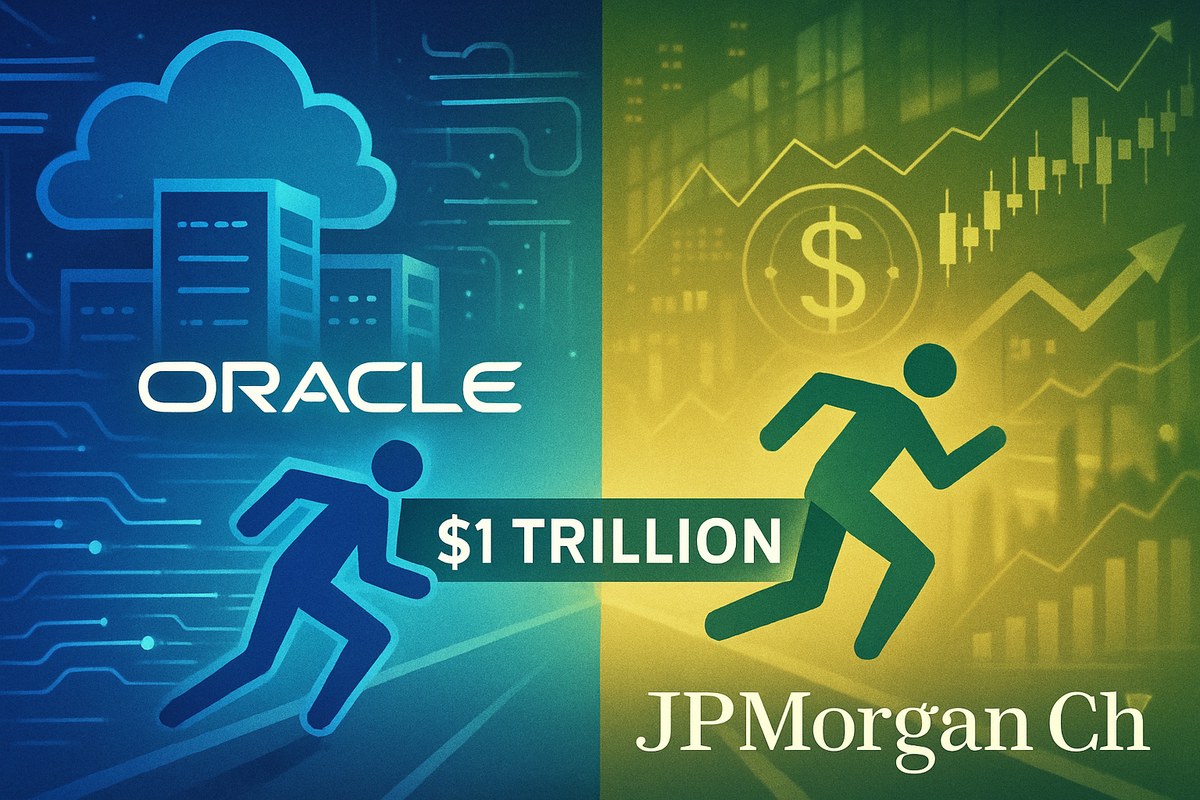
In the dynamic landscape of global finance and technology, two titans, Oracle Corporation (NYSE: ORCL) and JPMorgan Chase & Co. (NYSE: JPM), are locked in a compelling race to become the next company to consistently hold a market capitalization of $1 trillion. As of October 2025, both companies stand remarkably close to this coveted milestone, showcasing robust financial health and ambitious strategic trajectories. This high-stakes competition reflects broader shifts in the global economy, where technological innovation and financial resilience are paramount.
The current financial standing places JPMorgan Chase slightly ahead in the immediate pursuit, with its market cap hovering around $852.51 billion to $864.58 billion USD. Oracle, not far behind, boasts a market capitalization of approximately $813.13 billion to $815.73 billion USD. This tight race underscores the significant growth each company has achieved, driven by distinct yet equally impactful strategies. The outcome of this race will not only reshape their respective industries but also signal the prevailing economic forces driving market valuations in the mid-2020s.
The Titans' Playbook: Strategy and Performance Unveiled
JPMorgan Chase, a global financial services powerhouse, has demonstrated exceptional resilience and strategic foresight. For the second quarter of 2025, the bank reported an impressive net income of $15 billion and earnings per share (EPS) of $5.24, with managed revenue reaching $45.7 billion. A significant driver of this performance is the bank's diversified business model, spanning investment banking, consumer banking, commercial banking, and asset management. The firm's proactive investment in artificial intelligence (AI) is transforming operations, enhancing automation, decision-making, and customer engagement. Furthermore, strategic product expansions, such as the new fixed income platform for retail clients, aim to democratize bond trading and broaden revenue streams. The bank's strong Common Equity Tier 1 (CET1) capital ratio of 15% further solidifies its financial stability.
On the technology front, Oracle Corporation has aggressively pivoted towards cloud infrastructure and AI, which are now the primary engines of its growth. In the first quarter of fiscal year 2026 (ended August 31, 2025), Oracle reported total revenues of $14.9 billion, a 12% year-over-year increase. Cloud revenues, encompassing Infrastructure-as-a-Service (IaaS) and Software-as-a-Service (SaaS), surged by 28% to $7.2 billion, with Oracle Cloud Infrastructure (OCI) revenue skyrocketing by 55% to $3.3 billion. Oracle's leadership projects OCI to expand by 77% to $18 billion in fiscal 2026, with an audacious target of $144 billion within five years. This ambitious growth is underpinned by a record $455 billion in Remaining Performance Obligations (RPO), a staggering 359% year-over-year increase, largely fueled by multi-billion dollar AI contracts with industry giants like OpenAI, xAI, Meta Platforms (NASDAQ: META), Nvidia (NASDAQ: NVDA), and Advanced Micro Devices (NASDAQ: AMD). The company's commitment to building 37 new multi-cloud data centers with a $35 billion capital expenditure in fiscal 2026 highlights its aggressive expansion strategy.
Market Positioning and Competitive Edge
JPMorgan Chase's path to $1 trillion is paved by its unparalleled scale, diversified revenue streams, and deep integration into the global financial system. Its strategic focus on digital transformation, including real-time payments and digital wallets, coupled with hyper-personalization through AI, keeps it at the forefront of financial innovation. The bank's global reach provides a stable foundation, allowing it to navigate regional economic fluctuations. Recent initiatives, such as the extension of its data access agreement with Plaid and a strategic partnership with Coinbase (NASDAQ: COIN) for simplified crypto access, demonstrate its adaptability to emerging financial technologies. The upcoming launch of "J.P. Morgan Personal Investing" in the UK further signifies its intent to capture a larger share of the wealth management market. However, the financial sector faces increasing regulatory scrutiny, particularly concerning AML compliance and sanctions breaches, which could pose challenges.
Oracle's trajectory is defined by its explosive growth in the high-demand cloud and AI sectors. The company's aggressive pursuit of AI workloads, securing massive contracts, positions it as a critical infrastructure provider for the burgeoning AI industry. Oracle's multi-cloud strategy and its willingness to embed generative AI capabilities into its cloud suite without additional cost are significant competitive differentiators. CEO Safra Catz's stated ambition for Oracle to become one of the world's largest cloud infrastructure companies underscores its commitment. The return to a dual-CEO model with Clay Magouyrk and Mike Sicilia in September 2025 is seen as a strategic move to align leadership with its cloud and AI growth objectives. While Oracle's growth is rapid, it operates in a highly competitive hyperscaler market dominated by Amazon Web Services (NASDAQ: AMZN), Microsoft Azure (NASDAQ: MSFT), and Google Cloud Platform (NASDAQ: GOOGL), where pricing, reliability, and feature innovation are constant battles.
Broader Industry Trends and Their Implications
The race between Oracle and JPMorgan Chase is emblematic of broader industry trends shaping the global economy. For JPMorgan Chase, the financial services industry in 2025 is characterized by the accelerating adoption of AI for hyper-personalization, the proliferation of embedded finance, and the dominance of real-time payments. Digital trust and cybersecurity remain paramount, with banks investing heavily to protect customer data and combat financial crime. The bank's ability to leverage AI for predictive analytics, fraud detection, and personalized customer experiences will be crucial for maintaining its competitive edge. Moreover, a stable interest rate environment and continued economic growth, as projected by J.P. Morgan Research anticipating the S&P 500 to close near 6,000 by year-end, would provide a favorable backdrop for its lending and investment activities.
Oracle's journey is deeply intertwined with the relentless expansion of cloud computing and the AI revolution. Cloud trends for 2025 include the growing demand for AI-powered cloud services, the prevalence of hybrid and multi-cloud strategies, and the rise of edge and serverless computing. Oracle's massive investments in data center expansion and its focus on industry-specific cloud solutions align perfectly with these trends. The company's success in securing multi-billion dollar AI contracts highlights its strategic positioning as a key enabler of AI innovation. The increasing competition among hyperscalers, however, means Oracle must continue to innovate rapidly, offer compelling value, and ensure the reliability and scalability of its cloud infrastructure to capture market share and sustain its high growth rates. Regulatory considerations around data privacy, AI ethics, and cloud security will also play an increasingly significant role.
The Road Ahead: Potential Scenarios and Outcomes
Looking ahead, both Oracle and JPMorgan Chase face distinct short-term and long-term possibilities. For JPMorgan Chase, continued steady growth is anticipated, driven by its diversified operations and strategic investments in technology. Analysts project JPM to reach $300 by the end of 2025 and potentially $450 by the end of 2026. The bank's strong balance sheet and global presence provide a cushion against economic volatility, while its ongoing digital transformation and expansion into new financial services segments offer avenues for sustained growth. Potential strategic pivots might involve further acquisitions in fintech or wealth management to accelerate market penetration and technological capabilities. Challenges could arise from unforeseen economic downturns, intensified regulatory pressures, or disruptive innovations from non-traditional financial players.
Oracle's future outlook is highly optimistic, largely predicated on the successful execution of its ambitious cloud and AI strategy. Management expects total cloud growth to accelerate from 24% in fiscal year 2025 to over 40% in fiscal year 2026. The projected exponential growth of OCI revenue, from $18 billion in fiscal 2026 to $144 billion in 2030, paints a picture of aggressive market capture. Oracle's ability to convert its massive Remaining Performance Obligations into revenue will be a critical determinant of its success. Market opportunities include becoming the dominant cloud provider for AI workloads and expanding its footprint in specialized industry clouds. However, challenges include intense competition from established hyperscalers, the significant capital expenditure required for data center expansion, and the need to continuously innovate to stay ahead in the rapidly evolving AI landscape. A key strategic pivot could involve further deepening partnerships with AI innovators and expanding its global data center network at an even faster pace.
Conclusion: A Race for the Ages
The race between Oracle and JPMorgan Chase to the $1 trillion market capitalization is more than just a financial milestone; it is a testament to the enduring power of strategic vision, technological innovation, and market adaptation. JPMorgan Chase, with its established global financial empire and robust diversification, represents a more stable, albeit potentially slower, ascent to the trillion-dollar club. Its consistent performance, strategic embrace of AI in financial services, and expansion into new client segments position it as a resilient contender.
Conversely, Oracle's journey is characterized by explosive growth fueled by its aggressive pivot to cloud infrastructure and its pivotal role in enabling the AI revolution. The sheer scale of its AI contracts and the ambitious projections for OCI revenue suggest a potentially faster, though perhaps more volatile, path to and beyond the $1 trillion mark. Investors should closely monitor Oracle's execution on its cloud and AI strategies, particularly its ability to convert its substantial RPO into realized revenue and its success in fending off intense competition in the cloud market. For JPMorgan Chase, key indicators will be its continued earnings growth, successful integration of new technologies, and its ability to navigate the evolving regulatory landscape. Both companies offer compelling narratives, and the next few years will undoubtedly provide a fascinating spectacle as they vie for this significant market valuation.
This content is intended for informational purposes only and is not financial advice.






